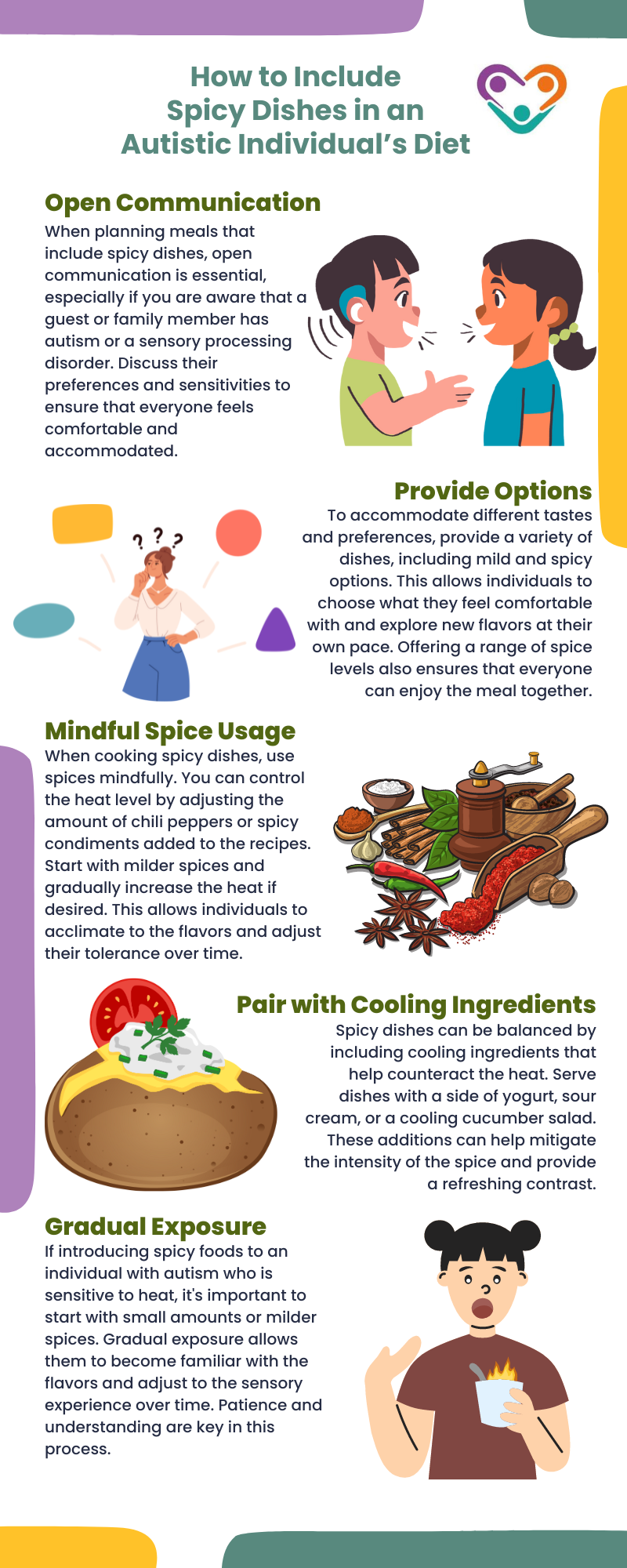Many individuals with autism have difficulty describing what they like or dislike about certain foods. This makes it challenging to understand what specific aspects of food are important or distressing for them, which can lead to an increased risk of meltdowns.
According to research, individuals with autism often have strong preferences for carbohydrates and processed foods over fruits and vegetables, reflecting aversions to certain tastes and textures.
This preference can potentially result in nutritional deficiencies and weight gain, particularly if coupled with limited exercise.
But what about spicy foods? Are autistic individuals naturally inclined to like them? Let’s find out.

Sensory Sensitivities and Food Choices
Sensory sensitivity in children and adults on the autism spectrum extends beyond flavors to include sensitivity to the color, smell, and texture of foods.
Due to sensory differences, autistic individuals may have difficulty eating healthily. Those who are under-sensitive may love very strong flavors and tolerate very hot and spicy foods. On the other hand, some individuals may experience hypersensitivity to certain tastes or textures, leading to a limited range of preferred foods.
Moreover, many individuals with autism have a narrow selection of preferred foods and may exhibit specific rituals, such as needing foods in particular positions on the plate or using the same plate for every meal.
Introducing new foods to individuals with autism can be challenging due to their need for sameness, making changes in their diet as distressing as unexpected events.

Spicy Foods and Autism
For individuals with autism, navigating food preferences can be a challenge, especially when it comes to spicy foods. Sensory sensitivities, which are common in autism, can extend beyond flavors to include sensitivity to the color, smell, and texture of foods.
That said, let’s look at sensory sensitivity to spicy foods and provide tips for including spicy dishes in the diet of individuals with autism.
Sensory Sensitivity to Spicy Foods
Autistic individuals may have varying responses to spicy foods due to their sensory differences. Some who are under-sensitive may actually seek out very strong flavors and tolerate hot and spicy foods well. On the other hand, those who are over-sensitive may find the heat and intensity of spicy foods overwhelming and uncomfortable.
It’s important to remember that each individual with autism is unique, and their sensitivity to spicy foods can vary. Some may enjoy mild levels of spice, while others may prefer to avoid it altogether.
It’s essential to respect their preferences and take their sensory sensitivities into consideration when planning meals.
Tips for Including Spicy Dishes
If you want to include spicy dishes in the diet of an individual with autism, here are some tips to make it a more enjoyable experience:

By being mindful of sensory sensitivities and using these tips, you can navigate including spicy dishes in the diet of individuals with autism.
Remember to prioritize open communication, provide options, and adapt recipes to accommodate different spice preferences. With careful planning and consideration, you can create an inclusive and enjoyable dining experience for everyone involved.
Conclusion
Keep in mind that every individual with autism is unique, and their relationship with food, including spicy foods, will be equally unique. Understanding their sensory sensitivities, taste preferences, and communication styles is key to supporting their dietary choices.
Whether they love spicy food or avoid it, the most important thing is to respect their preferences and create a positive and supportive mealtime environment.
By being patient, flexible, and attentive to their needs, you can help individuals with autism enjoy a varied and satisfying diet that includes (or excludes) spicy foods according to their personal preferences.
Research continues to shed light on the neurological basis of sensory issues in autism, offering hope for more targeted and effective therapies in the future. By recognizing and addressing sensory processing difficulties, we can improve the quality of life for individuals with autism and their families. If you’re seeking specialized ABA therapy in New Jersey, Indiana, Georgia, and New York, Golden Care offers comprehensive services tailored to meet the unique needs of each individual. Contact us to learn more or book a consultation today.
Sources:
https://www.autismcentral.org.uk/guidance/eating
https://www.autismspeaks.org/expert-opinion/what-it-about-autism-and-food



